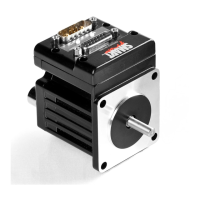Moog Animatics SmartMotor™ Developer's Guide,Rev. L
Page 177 of 909
ADTS=formula, ATS=formula, DTS=formula
Accel. Targets for Synchronized Move
Like the velocity parameter, ADTS pertains to the combined path motion. The PTS() command
scales the path velocity and accelerations set by the VTS= and ADTS= commands so that each
axis reaches its constant velocity portions at exactly the same time, creating combined,
straight-line motion. The ADTS= command sets both acceleration and deceleration, whereas
ATS= and DTS= allow you to set separate acceleration and deceleration where desired.
PTSS(), PRTSS()
Pos. Target Synch. Abs. and Rel., Supplemental
The PTSS() and PRTSS() commands allow supplemental axis moves to be added and
synchronized with the previous PTS() or PRTS() commanded motion. Issue these additional
axis commands after a PTS() or PRTS() command, but before the next GS. These commands
allow the user to identify one axis position (posn) and associated axis CAN addresses (axisn)
at a time.
PTSS(posn;axisn)
The supplemental axis motions will start at exactly the same time as the main PTS() or
PRTS() motion. With the next GS, they will transition from their accelerations to their slew
velocities at exactly the same time, and decelerate and stop at exactly the same time.
Moves too short to ever reach the VTS= velocity will execute a triangular rather than
trapezoidal profile, but the moves will still be synchronized.
The difference between a PTSS() move and a PTS() member is that the supplemental axis
moves do not reduce the primary profile velocity in an effort to hold the total motion to a total
combined velocity set by VTS. The same applies for acceleration. The combined motion of the
PTS() move will be controlled to the VTS limit, and then PTSS() moves will simply align with
that combined motion.
ADTS=100 'Set target synchronized accel/decel
VTS=100000 'Set target synchronized velocity
x=1000 y=2000 z=3500 a=100 b=200
PTS(x;1,y;2,z;3) 'Set next positions, axes 1, 2 & 3
PTSS(a;4) 'Set supplemental position, axes 4
PTSS(b;5) 'Set supplemental position, axes 5
GS 'Go, starts the synchronized move
NOTE: If the supplemental axis move is longer than the PTS() move, the
supplemental axis velocity will exceed the limit set by VTS=.
A Note About PTS and PTSS
The PTS and PTSS commands can sometimes give unexpected results. The calculations may
yield values for velocities and accelerations that are very low, very high or zero.
That behavior may be caused by previous operating modes leaving the trajectory calculations
in a state where the target and actual positions are not equal (or even close to equal). To
prevent this, place each motor into position mode with the target position set to the actual
(current) position before using the PTS or PTSS command. This is done by issuing the
Part 1: Programming: ADTS=formula, ATS=formula, DTS=formula

